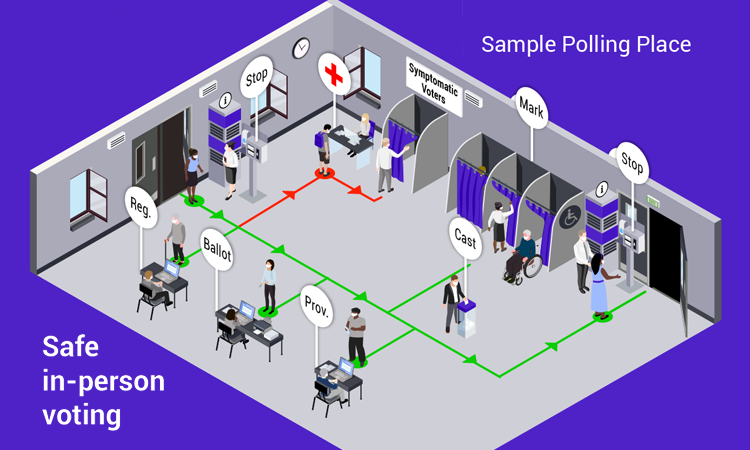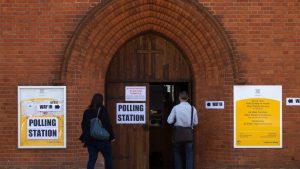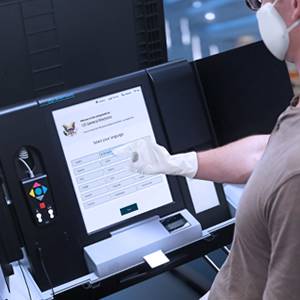
While many Americans will choose to vote by mail during this pandemic, we all know that in-person voting is not going to go away. Even states like Oregon that are fully vote by mail offer in-person voting and ballot drop-off locations. So how can jurisdictions create safe in-person voting sites?
Perhaps the first step is to accept the fact that no space that attracts a random cross-section of individuals can be completely risk free. The best election officials can hope for (and work toward) is a risk level comparable to grocery shopping, doctor’s visits or going inside a post office.
Beyond acknowledging these limits, here are steps that election officials can take to minimize the risk of coronavirus spread among workers, volunteers and voters. We’ve also created a sample safe polling place diagram that you can download and use in your planning efforts. [Click link to open image in new window. Right click image. Select “Save Image As”]

Relocate polling places
Polling places should not be located at sites where disproportionately high numbers of coronavirus infections have been reported. Nor should they be located in high-risk facilities, such as senior care or retirement facilities, where COVID-19 deaths tend to be highest.
Polling place decisions should be made and publicly communicated early, with as much notice to voters as possible. In developing these plans, officials should seek input from affected communities, such as African American, Latino, Asian, and Native American voters, language-minority voters, voters with disabilities, and students.
Maximize the number of polling places
If possible, county and local election officials should exercise their discretion to maximize the number of polling places within their respective jurisdictions. More polling places means fewer voters assigned to each polling place, reducing the chances for crowding. Election officials might achieve this goal by declining to consolidate polling places that received low numbers of in-person votes in previous elections, dispersing polling places to the greatest extent possible, or assigning the smallest legally permissible number of voters or precincts to each polling place. Larger facilities may offer a good addition or alternative to smaller polling places, allowing for more distance between voting machines/booths, poll workers, voters, etc.
Recruit additional poll workers
Additional poll workers will be needed to assist with in-person voting as well as ballot processing. As noted above, election officials should develop robust recruitment plans immediately, placing particular emphasis on groups that do not face heightened risks from the coronavirus. Election officials should also be prepared for higher-than-usual falloff rates if poll workers become ill or decide at the last minute that the risks of serving on Election Day are too great.
Sanitize polling places
 Election officials should ensure that each polling place is well-stocked with antibacterial, antimicrobial cleaning supplies, and soap and water to disinfect high-traffic surfaces (such as check-in tables), voting machines and voting equipment (including pens and touchpads) between each use. If funds allow, air filtration devices capable of removing airborne coronavirus should be purchased for every voting site, back-office locations and warehouses. For more information, the CDC has issued Recommendations for Election Polling Locations, and the U.S. Election Assistance Commission has Coronavirus (COVID-19) Resources available. These are very high-level directives and for them to really be effective jurisdictions would benefit from them being customized to their individual sites by an infectious disease expert. (Smartmatic can help with this.)
Election officials should ensure that each polling place is well-stocked with antibacterial, antimicrobial cleaning supplies, and soap and water to disinfect high-traffic surfaces (such as check-in tables), voting machines and voting equipment (including pens and touchpads) between each use. If funds allow, air filtration devices capable of removing airborne coronavirus should be purchased for every voting site, back-office locations and warehouses. For more information, the CDC has issued Recommendations for Election Polling Locations, and the U.S. Election Assistance Commission has Coronavirus (COVID-19) Resources available. These are very high-level directives and for them to really be effective jurisdictions would benefit from them being customized to their individual sites by an infectious disease expert. (Smartmatic can help with this.)
Public health measures
Polling places should be equipped with Stop Stations to provide voters with PPE and hand sanitizer, and to take temperatures (if permitted by law). Ideally, the Stop Station should be located outside room where voting takes place, either outdoors, in a separate room or in a hallway. If none of these alternatives is available, the Stop Station should be just inside the polling station entryway.
If permitted by state and federal law (including privacy laws), and consistent with anti-discrimination and equal protection principles, polling stations should have accommodations for any person known to be infected with the coronavirus or exhibiting symptoms. This can include voting in a separate room (if available) or using separate, segregated equipment. If no provisions are available and state law supports it, any such person should immediately be provided with either the appropriate absentee ballot or an absentee ballot request form/application.
Voluntary high-risk zones
When the size and set-up of polling places allow, officials should consider creating “high-risk” zones for voters who self-identify as immune-compromised or having other risk factors to line up, check-in, and vote at a distance from other voters.
Limit voter proximity in polling places
Polling place officials should promote social distancing by limiting voters’ proximity to each other and to other people, including poll workers. For example, officials might place wayfinding indicators (this can be a simple as a piece of masking tape on the ground) six feet from each polling place official’s desk to indicate where voters should stand when checking in and interacting with them. They should also place floor wayfinding at approximately six-foot intervals to mark where voters should wait in line. Voters should be encouraged to line up outside of the polling place, if possible, rather than congregating indoors.
There also more great information about safe in-person voting in this series of five very short videos with Michael Diamond, co-founder of The Infection Prevention Strategy (TIPS). TIPS is a global health nonprofit active in preventing the spread of infectious disease.